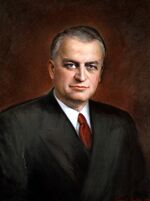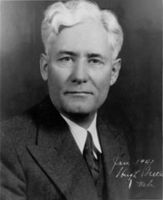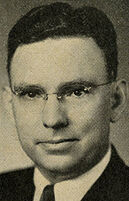Old Right
 From Conservapedia
From Conservapedia 
In the United States, the Old Right refers to a faction of American conservatives who both opposed Franklin D. Roosevelt's New Deal left-wing programs and were also non-interventionists (isolationists) opposing entry into World War II. The Old Right was mostly active during 1930s–50s. Many were associated with the Republicans led by Robert Taft, though some were Democrats.
Notable people include President Warren G. Harding, President Calvin Coolidge, and William Randolph Hearst. Writers among the faction included John T. Flynn, Albert Jay Nock, Rose Wilder Lane, and Garet Garrett.[1]
Indiana conservative Republican Charles A. Halleck once stated that Americans should:[2]
| “ | ...live again as God meant us to live and not as some bureaucrat in Washington … would like us to live. | ” |
The Old Right is often associated with the Conservative Coalition, though the two are not interchangeable. The latter was focused primarily on opposition towards domestic economic initiatives with no unity on foreign policy, due to the rift on the issue between isolationism-favoring Republicans and internationalism-favoring Democrats.
Although the Old Right as a group was not primarily focused on civil rights, many of its Republican leaders supported efforts to pass anti-lynching legislation, among a number of bills aimed at ensuring equality for blacks. Sen. Robert Taft helped lead an effort in 1950 to pass a "voluntary FEPC" bill that emphasized ending racial discrimination in the workplace without taking forceful government actions.[3]
Contents
Ideology[edit]
The Old Right was marked by the following characteristics:
- Opposition towards big government, bureaucracy, and the New Deal
- Fiscal conservatism
- Non-Interventionism and opposition towards globalism/internationalism
- Anti-communism
History and timeline[edit]
1920s: rejecting internationalism, progressivism and fiscal recklessness[edit]
Staunchly opposed to the internationalist agenda promoted by Woodrow Wilson, prominent Old Right figures in the Republican Party helped kill the Treaty of Versailles from passing the U.S. Senate.[4] Massachusetts senator Henry Cabot Lodge, Sr., a prominent conservative and nationalist, had said of the Wilson Administration's agenda:[5]
| “ | The United States is the world’s best hope, but…if you tangle her in the intrigues of Europe, you will destroy her powerful good, and endanger her very existence… Beware how you trifle with your marvelous inheritance — this great land of ordered liberty. For if we stumble and fall, freedom and civilization everywhere will go down in ruin. | ” |
During the 1920s, President Calvin Coolidge spearheaded the causes promoted by the Old Right, rejecting progressivism and advocating fiscal restraint.[6] His reduction of tax rates promoted economic growth, and a particular achievement during his presidency was slashing the national debt.[7] Coolidge and the Old Right also passed and supported the Johnson-Reed Act, which strongly cut immigration rates and barred immigration from Asia.
1930s: opposition towards New Deal[edit]
In the wake of the Great Depression, the failures of President Herbert Hoover dragged the Republican Party into the minority party in Congress, and Franklin D. Roosevelt was elected in the 1932 presidential election by a landslide.
When Roosevelt took office, he quickly began establishing a series of federal programs known as the New Deal. The First New Deal programs received support from some congressional Republicans who emphasized relief for struggling Americans. This included House GOP leader Bertrand H. Snell, who stated in his support of the 1933 Emergency Banking Act:[9]
| “ | The house is burning down, and the President of the United States says this is the way to put out the fire. And to me at this time there is only one answer to this question, and that is to give the President what he demands and says is necessary to meet the situation. | ” |
Other early New Deal programs which received some support from conservative Republicans included the Agricultural Adjustment Act of 1933.[10] However, many quickly came to reject the increasing liberalism, bureaucracy, and totalitarianism of the programs, and the opposition solidified during the era of the Second New Deal.

Examples of Old Right figures who symbolized fierce opposition towards the New Deal included U.S. senator Frederick Hale of Maine, who disapproved of such programs even more frequently than his colleague Wallace H. White.[11] Hale particularly voted against the National Labor Relations Act of 1935 (known as the Wagner Act),[12] as well as the Social Security Act.[13]
The political power of the Old Right solidified in the wake of the 1937 court packing scheme. President Roosevelt, irritated over rulings by the United States Supreme Court striking down key New Deal legislation, sought to increase the number of total justices on the Court by introducing the Judiciary Procedures Reform Bill of 1937 so he could appoint stalwart allies of his liberal agenda.
Republican senator Arthur H. Vandenberg organized the Conservative Coalition in soundly defeating the vain power-grab scheme,[14] with the U.S. Senate voting 70–20 to recommit the bill to committee.[15] The U.S. House, while refusing to pass the Judiciary Procedures Reform Bill,[16] managed to pass a substitute bill which provided further incentives for the retirement of Supreme Court justices for Roosevelt to thus replace.[17]
The majority of Americans during the time opposed the court packing plan.[18] In the 1938 midterms, the Democratic Party lost a substantial number of House and Senate seats, though still retained a strong majority. President Roosevelt attempted to "purge" congressional Democrats he deemed not liberal/radical enough, including Guy Gillette of Iowa, Walter F. George of Georgia, Patrick McCarran of Nevada, and Millard E. Tydings of Maryland.[19] The effort failed, with all four senators winning renomination and re-election.
Increasing anti-New Deal sentiment among some Democrats contributed to the increasing power of the Conservative Coalition, which moved to block liberal legislation.
1940s: World War II and aftermath[edit]
During the 1930s, most Republicans were isolationists who opposed U.S. entanglement in complicated world affairs. This non-interventionism among the Old Right began to diminish following the attack on Pearl Harbor, which generated sharp sentiment among Americans for involvement in World War II.
However, the largely non-interventionist Republicans of the Old Right remained firm in opposing key aspects of President Roosevelt's foreign policy. This included the vast majority of congressional Republicans voting against the 1941 Lend-Lease Act.[20] Conservatives also expressed concern and opposition towards policies such as rationing, with Rep. Charles Halleck of Indiana criticizing bureaucrats "snooping into our ice boxes."[2]

|

|

|
Nebraska Old Right Republican politicians Kenneth S. Wherry (left), Hugh A. Butler (center), and Howard H. Buffett (right). | ||
In the early 1940s, two key non-interventionist Republicans were elected U.S. senators from Nebraska – Kenneth Wherry and Hugh A. Butler. The latter handily defeated Democrat governor Robert L. Cochran in the 1940 elections,[21] while the former was elected in the following 1942 midterms by ousting liberal RINO George Norris.[22] Butler in particular criticized the Roosevelt Administration in 1944 regarding foreign aid to Latin America,[23] and also later condemned what he described as:[24]
| “ | ...the secrecy in which foreign discussions have been conducted. | ” |
Another key Old Right Republican figure elected in the 1942 midterms was businessman Howard Buffett.[25] Described as an "arch-conservative," Buffett was a leading opponent of foreign aid programs.[26] A member of the John Birch Society, Buffett would later write in 1956:[27]
| “ | Today’s situation is the result of an alarming and devious governmental intervention in the economic affairs of the nation for objectives not contemplated by the men who wrote the Constitution.
Historically, in America the producer was protected by government in the enjoyment of the fruits of his labors. That protection of his property explains the glorious material progress already recounted. The last 40 years have seen a gigantic expansion of political power over economic affairs by the federal government. This change is linked by many scholars to the passage of the income tax law in 1913. |
” |
Buffett notably drew "0" ratings from the Americans for Democratic Action, a liberal political organization.[28] He also supported a return to the gold standard,[29] and served as Robert Taft's 1952 campaign manager for the Midwest.[30]

1950s: Taft vs. Eisenhower, decline of the Old Right[edit]
Sen. Taft sought the presidency in the 1952 presidential election, and faced General Dwight Eisenhower in the Republican primaries. The former was an adamant conservative and isolationist while the latter was considerably more moderate and favored internationalism.
B. Carroll Reece, an Old Right-oriented conservative Republican from Tennessee's 1st congressional district, stated in mid-December 1951 that the southern and border states' GOP delegations for the Republican National Committee would solidly back Taft for the party nomination.[31] Indeed, the southern Republican delegations including the Mississippi delegation led by longtime black GOP leader Perry Wilbon Howard, II[32] and the Arkansas delegation led by Osro Cobb voted for Taft.
The "black and tan" delegations symbolized the GOP's pro-civil rights roots and came to the support of the Ohio senator who was firmly supportive of racial equality[3][33] over Eisenhower – who while is known for pro-civil rights victories later during his presidency – had initially wavered on the issue of segregation.[34]
Ultimately, Eisenhower won the Republican nomination in part due to a maneuver by New York lawyer Herbert Brownell,[35] who would later prove instrumental in landmark desegregation efforts. In the general election, Eisenhower defeated Illinois liberal Democrat Adlai E. Stevenson, II by a landslide for the presidency.
During the Eisenhower presidency, the isolationism of many Old Right Republicans began to wane. One instance was on the issue of foreign aid, where Indiana congressman Charles Halleck had been willing to compromise and vote for.[36] Homer E. Capehart, a Republican U.S. senator from the state, similarly had been an isolationist initially though inclined to support the Eisenhower Administration's foreign policy frequently.[37][38]
1960s: rise of Goldwater and New Right, evaporation of the Old Right[edit]
The political rise of Arizona Sen. Barry Goldwater, along with the surging influence of figures such as William F. Buckley, Jr., contributed to an increasing influence of the New Right which placed emphasis on U.S. intervention to prevent the global spread of communism.[39] This contrasted with the style of the Old Right, which favored non-interventionism.
In the 1964 presidential election, Goldwater ran against incumbent liberal Democrat Lyndon B. Johnson, campaigning on conservative credentials in opposing the New Deal and advocating hawkish foreign policy moves. His candidacy received the support of many Old Right GOP figures who shared his views on domestic policy, including Rep. Leslie C. Arends of Illinois.[40] Although he ultimately lost the general election to Johnson by a landslide in part due to intraparty rifts, Goldwater sparked a key revival of the conservative movement which later propelled Ronald Reagan to the presidency.
The influence of New Right-oriented policies among the Republican Party increased in the 1960s amidst the Vietnam War. Most conservatives emerged as supporters of the war, with only a few being vocal opponents. Among the latter, most notable was congressman Eugene Siler of Kentucky, who was the lone U.S. representative to vote against the Gulf of Tonkin Resolution.[41] Siler is considered a forerunner to current Kentucky libertarian conservatives Rand Paul and Thomas Massie.[42]
Left-wing smears[edit]
Leftists, who long despised the policies of the Old Right, have set out to smear the group. A writer for JSTOR in 2016 published an article suggesting the Old Right was a precursor to the contemporary "alt-right."[43] This was cited in an article by the far-left Salon, which absurdly perpetuated the argument.[44]
See also[edit]
References[edit]
- ↑ Richman, Sheldon L. (January 1, 1990). The Old Right Was Right. Mises Institute. Retrieved October 16, 2021.
- ↑ 2.0 2.1 Crass, Scott (July 10, 2013). Ford Unseated Halleck As Republican Whip In 1965. The Moderate Voice. Retrieved October 16, 2021.
- ↑ 3.0 3.1 Fascinating Politics (April 30, 2019). Robert Taft’s Conservative Proposal for Civil Rights. Mad Politics: The Bizarre, Fascinating, and Unknown of American Political History. Retrieved October 16, 2021.
- ↑ Fascinating Politics (March 3, 2020). Versailles Treaty, in Six Key Votes. Mad Politics: The Bizarre, Fascinating, and Unknown of American Political History. Retrieved October 16, 2021.
- ↑ Fascinating Politics (September 22, 2019). Henry Cabot Lodge: American Nationalist. Mad Politics: The Bizarre, Fascinating, and Unknown of American Political History. Retrieved October 16, 2021.
- ↑ Postell, Joseph (February 20, 2013). Calvin Coolidge: Forefather of Our Conservatism. Heritage Foundation. Retrieved October 16, 2021.
- ↑ Shlaes, Amity; Thomas, Rushad (January 30, 2015). Coolidge’s Fiscal Triumph. Coolidge Foundation. Retrieved October 16, 2021.
- ↑ B.H. Snell digital file from original neg.. Library of Congress. Retrieved October 16, 2021.
- ↑ Woods, Jr., Thomas E. (August 13, 2008). The Great Gold Robbery of 1933. Mises Institute. Retrieved October 16, 2021.
- ↑ TO PASS H.R. 3835 (P.L. 10) TO RELIEVE THE EXISTING NATIONAL ECONOMIC EMERGENCY BY INCREASING AGRICULTURAL PURCHASING POWER, TO RAISE REVENUE FOR EXTRAORDINARY EXPENSES INCURRED BY REASON OF SUCH EMERGENCY, TO PROVIDE EMERGENCY RELIEF WITH RESPECT TO AGRICULTURAL INDEBTEDNESS, TO PROVIDE FOR THE ORDERLY LIQUIDATION OF JOINT-STOCK LAND, BANKS, AND FOR OTHER PURPOSES.. GovTrack.us. Retrieved October 16, 2021.
- ↑ Fascinating Politics (September 23, 2018). How the Northeast Became Democratic, Part IV: Maine (Sort of). Mad Politics: The Bizarre, Fascinating, and Unknown of American Political History. Retrieved October 16, 2021.
- ↑ TO PASS S. 1958, A BILL TO PROVIDE FOR SETTLEMENT OF LABOR DISPUTES.. GovTrack.us. Retrieved October 16, 2021.
- ↑ TO PASS H.R. 7260.. GovTrack.us. Retrieved October 16, 2021.
- ↑ Debates on the Federal Judiciary: A Documentary History. Federal Judiciary Center. Retrieved October 16, 2021.
- ↑ TO RECOMMIT TO THE COMMITTEE ON THE JUDICIAL BRANCH OF GOVERNMENT. S. 1392, A BILL TO REORGANIZE THE JUDICIARY BRANCH.. GovTrack.us. Retrieved June 29, 2021.
- ↑ Fascinating Politics (April 28, 2021). The Court Packing Episode. Mad Politics: The Bizarre, Fascinating, and Unknown of American Political History. Retrieved October 16, 2021.
- ↑ TO PASS H. R. 2518, (P. A. 10), A BILL PROVIDING FOR THE RETIREMENT OF JUSTICES OF THE SUPREME COURT.. GovTrack.us. Retrieved October 16, 2021.
- ↑ Zelizer, Julian E. (October 15, 2018). Packing the Supreme Court Is a Terrible Idea. The New York Times. Retrieved October 16, 2021.
- ↑ Fascinating Politics (May 13, 2018). The Purge – FDR Edition. Mad Politics: The Bizarre, Fascinating, and Unknown of American Political History. Retrieved October 16, 2021.
- ↑ TO PASS H.R. 1776, A BILL TO PROMOTE THE DEFENSE OF THE UNITED STATES (LEND-LEASE BILL).. GovTrack.us. Retrieved October 16, 2021.
- ↑ NE US Senate Race - Nov 05, 1940. Our Campaigns. Retrieved October 16, 2021.
- ↑ NE US Senate Race - Nov 03, 1942. Our Campaigns. Retrieved October 16, 2021.
- ↑ January 21, 1944. BUTLER AGAIN HITS LATIN-AMERICA AID; He Tells Senate Government Fails to Upset His Charge of Spending in Billions. The New York Times. Retrieved October 16, 2021.
- ↑ February 27, 1945. Butler Demands Full Account Of Roosevelt's World Parleys. The New York Times. Retrieved October 16, 2021.
- ↑ NE - District 02 Race - Nov 03, 1942. Our Campaigns. Retrieved October 16, 2021.
- ↑ April 30, 1964. HOWARD BUFFETT, 60, AN EX‐CONGRESSMAN. The New York Times. Archived version available here. Retrieved October 16, 2021.
- ↑ Klein, Philip (September 20, 2012). Buffett's dad was the Ron Paul of his day. Washington Examiner. Retrieved October 16, 2021.
- ↑ Rothbard, Murray N. (August 1994). Life in the Old Right. LewRockwell.com. Retrieved October 16, 2021.
- ↑ Lubin, Gus (February 14, 2012). Tired Of Warren Buffett Trashing Gold? Here Are Some Quotes From His Gold-Loving Father. Business Insider. Retrieved October 16, 2021.
- ↑ Rothbard, Murray N. (June 10, 2005). Confessions of a Right-Wing Liberal. Mises Institute. Retrieved October 16, 2021.
- ↑ December 17, 1951. G.O.P. IN SOUTH SOLID FOR TAFT, SAYS REECE. The New York Times. Retrieved October 16, 2021.
- ↑ Apple, Jr., R.W. (August 31, 2004). THE REPUBLICANS: THE CONVENTION IN NEW YORK -- APPLE'S ALMANAC; Father of the Southern Strategy, at 76, Is Here for His 11th Convention. The New York Times. Retrieved October 16, 2021.
- ↑ Rothbard, Murray N. (June 21, 2011). Swan Song of the Old Right. Mises Institute. Retrieved October 16, 2021.
- ↑ Greenberg, David (August 10, 2000). The Party of Lincoln …. Slate. Retrieved October 16, 2021.
- ↑ BROWNELL, HERBERT JR.: Papers, 1877-1988. Eisenhower Presidential Library. Retrieved October 16, 2021.
- ↑ Fascinating Politics (April 14, 2021). Earl Landgrebe: Nixon’s Last Republican Defender. Mad Politics: The Bizarre, Fascinating, and Unknown of American Political History. Retrieved October 16, 2021.
- ↑ Cook, Joan (September 5, 1979). Homer E. Capehart Is Dead at 82; Was 3‐Term Senator From Indiana. The New York Times. Retrieved October 16, 2021.
- ↑ HOMER E. CAPEHART PAPERS, 1938–1962. Indiana Historical Society. Retrieved October 16, 2021.
- ↑ Riggenbach, Jeff (December 4, 2009). The Goldwater Anomaly. Mises Institute. Retrieved October 16, 2021.
- ↑ September 30, 1964. GOLDW ATER BACKER SCORES ‘HATE’ DRIVE. The New York Times. Retrieved October 16, 2021.
- ↑ Beito, David T.; Beito, Linda Royster. The Christian Conservative Who Opposed the Vietnam War. History News Network. Retrieved October 16, 2021.
- ↑ Fascinating Politics (November 2, 2019). Before Rand Paul, There Was Eugene Siler. Mad Politics: The Bizarre, Fascinating, and Unknown of American Political History. Retrieved October 16, 2021.
- ↑ Wills, Matthew (October 1, 2016). Is the “Alt-Right” The Grandchild of the Old Right?. JSTOR Daily. Retrieved October 16, 2021.
- ↑ Rosenberg, Paul (October 8, 2016). From the "old right" to the alt-right: How the conservative ideology of FDR's day fueled the rise of Trump. Salon via archive.is. Retrieved October 16, 2021.
External links[edit]
- The Old Right – LewRockwell.com, published April 18, 2013
| ||||||||||||||
Categories: [United States Politics] [United States History] [Republican Party] [New Deal] [Conservatives] [Libertarians] [Fiscal Conservatives] [Non-Interventionism] [Libertarianism] [Anti-establishment] [1920s] [1930s] [1940s] [1950s] [1960s] [Old Right]
↧ Download as ZWI file | Last modified: 02/18/2023 16:55:09 | 19 views
☰ Source: https://www.conservapedia.com/Old_Right | License: CC BY-SA 3.0
 ZWI signed:
ZWI signed:


 KSF
KSF